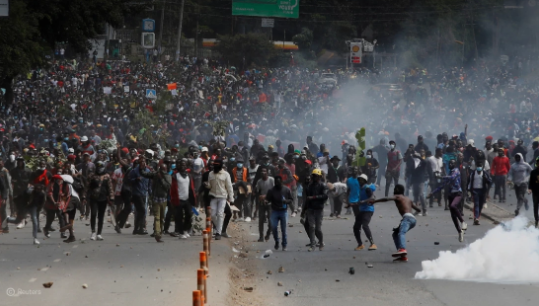The Kenyan shilling is expected to come under increased pressure in July due to anticipated declines in capital inflows, exacerbated by political instability, analysts have cautioned. According to insights from Stears, a pan-African market research firm, the currency experienced a 0.29% depreciation following the protests from June 18 to June 27.
This downward trend is projected to persist amidst ongoing anti-government demonstrations and an upcoming review by the IMF. The protests have severely impacted the economy, leading to disrupted business activities in Nairobi and other major cities, contributing to limited economic activity.
Analysts suggest that reduced capital inflows indicate constrained foreign exchange reserves available to the central bank, limiting its ability to stabilize the currency in the short term.
Additionally, the shilling’s performance will be influenced by the strength of the US dollar, which is expected to remain robust in July as the US Federal Reserve maintains a cautious approach ahead of potential rate adjustments.
“However, the shilling’s movements in July will ultimately depend on market sentiment regarding political developments, exchange rate expectations, and investor confidence. Stears forecasts the shilling to close Q3 2024 at Sh129.42 against the dollar,” Stears said in its monthly update.
It notes that although the ongoing protests may soon de-escalate, public discontent remains high.
“Regardless of the outcome, we expect relatively positive investor sentiments toward the Kenyan economy to wane. Investors will adopt a wait-and-see approach before bringing in capital,” the update reads.
This comes at a time that yields on Kenya’s sovereign dollar bonds declined to a five-month low, becoming one of the worst performing Emerging Market bonds since June 18, when the protests began.
“This indicates dwindling investor confidence. Additionally, we expect the protest and the government’s brutal response to feature in the IMF’s upcoming July review of the country’s economic progress,” Stears notes.
Kenya is facing significant challenges as it navigates stringent conditions imposed by the IMF, crucial for ensuring debt sustainability. President Ruto finds himself in a difficult position, balancing public demands with the expectations of multilateral lenders and investors closely monitoring the situation.
Analysts anticipate a potential easing of tensions in the coming weeks but foresee continued cautious market sentiment towards Kenya, especially amid calls for President Ruto’s resignation. The ongoing unrest has heightened dissatisfaction with the Ruto administration, posing security and stability concerns that could impact short-term macroeconomic stability and the prospects of a favorable IMF review in July.
Kenya is currently under IMF’s Extend Credit Facility (ECF) and Extended Fund Facility (EFF) programs, which mandate fiscal discipline, expenditure cuts, and improvements in tax and export revenues.
As per the May 2024 budget review, fiscal authorities have made significant efforts to meet these loan program requirements, aiming for a 16% reduction in expenditure compared to income in the fiscal year 2024.
“While these are commendable, the bulk of the austerity measures implemented due to these programmes have meant a substantial squeeze on income levels, worsening the cost of living in Kenya,” the report reads in part.
Unfortunately, the hardest hit by these policy changes are the low-middle income earners, comprising over 70 per cent of Kenya’s total consumer market.
Despite the bill being withdrawn, Kenyans still call for Ruto’s impeachment, a demand likely to persist soon.



